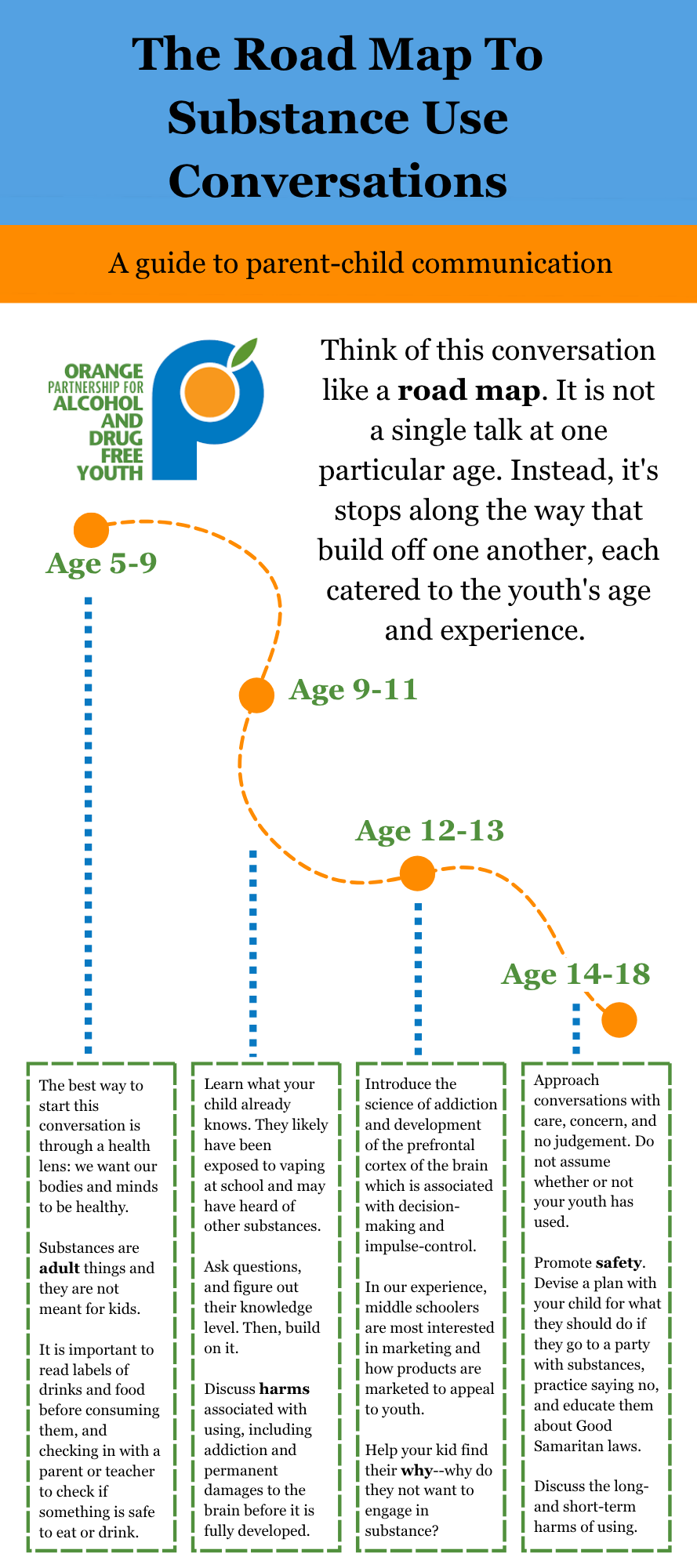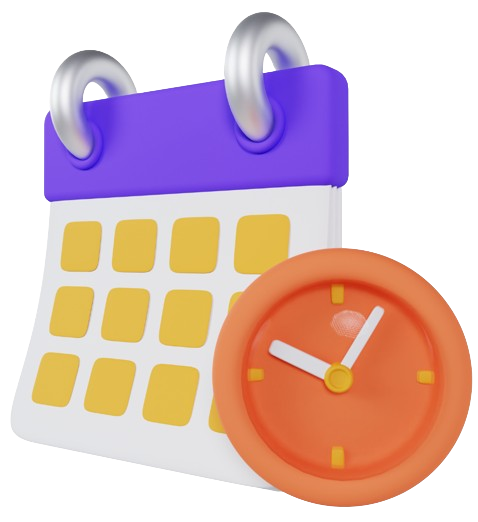Conversation Starters
Having conversations with youth about substance misuse is difficult. It takes time and preparation to know what to say, how to start, or why to discuss it. However, any parent, no matter how prepared they feel in the moment, may struggle in communicating with their child. Remember that a messy conversation is better than no conversation. And your kid is better off by having these talks early, with each moment building off the next, so that hopefully when your youth comes into contact with substances, they have the necessary knowledge and skills to say no.
Preparing for the Conversation
Preparing for these conversations can be difficult. However, there are a few things that can make preparation easier:
List of Services
-
GoalsList Item 1
Write down a list of goals you hope to gain from this conversation with your child. This will help you stay on track while you talk to them.
-
Talking PointsList Item 2
With your goals in mind, write down some talking points. This will help you keep the conversation going if you forget what you want to say. Include some questions in here to bring your kid back into the conversation!
-
Ask QuestionsList Item 3
Remember that this is an open and honest conversation free of judgement. Let your kid know that they are welcome to ask you any questions. And, when you ask them questions, make sure your child knows they come from a place of care and concern rather than judgement.
-
Frequent ConversationsList Item 4
Remember that this is an ongoing conversation. It is more beneficial to have multiple small "mini-talks" than one large conversation. This will give your child time to process and reflect, and will continually reinforce the harms of early substance initiation.
Parent Advisory Group

Orange Partnership's Parent Advisory Group meets regularly to determine best practices for bridging the gap in parent-child communication, substance use prevention, and mental health awareness through conversation, workshops, and information.
Check out when our next meeting is on our calendar:
To learn more, check us out on social media!
Appropriate Topics By Age
Think of this conversation like building blocks or a road map. It is not a single talk at one particular age. Instead, it's multiple talks that build off one another, each catered to the youth's age and experience. Our goal is that having multiple conversations will improve parent-child communication, openness, and knowledge.
Check out our recommended topic given your child's age here:
Kindergarten-3rd Grade
While some children in this age range may know about substances, most of them will not. Think of these conversations as building blocks; each will build onto the next so that by the end of adolescence, your youth will have a full understanding of substance misuse.
The best way to frame this conversation is through health. We want our children's bodies and minds to stay healthy and the best way to do that is to make sure kids are aware of what is going into their bodies, including potential substances.
It’s the same sort of conversation we have about nutrition. It’s important to know what harmful substances may go into our body, and always make sure to check with a parent before eating or drinking something.
Tips:
- Frame substances as “Adult” (i.e. This is daddy’s adult juice)
- Engage in substances away from children when possible
- Store substances away from children. Lock up your alcohol or keep it in a secure part of your refrigerator
- Practice safe celebrations. If substances and kids are present at a party, have two containers for “children” drinks and “adult” drinks
- Teach children to read the labels on products and know what could be bad for them
- If your child wants to get candy at the store, check to make sure it is appropriate for them. There has been an increase in cannabis products that are made to resemble candy
Let your child approach the subject with curiosity. Answer their questions the best you can.
4th-5th Grade
As youth move through elementary school, they become exposed to many substances either through class, on the bus, or by parents, older siblings, and friends. This may not be true for all 4th and 5th graders but usually, by the beginning of middle school, all of them have a base knowledge on substance abuse.
Vaping is the most prevalent problem within this age range. While they may not vape themselves, they are constantly exposed to it through TV shows, movies, and social media. Further, they may also see people vaping in real life or smoke shops on roads near their schools or houses.
The best way to frame this next conversation about substances is by meeting them where they are. Begin by asking what your child knows about substances, what they’ve heard and seen. Using that knowledge, you can build upon their knowledge.
Tips:
- Start with a question. Have you heard of people vaping? Do you know what’s in a vape?
- Remember that a vape is a tool, not a substance. Vapes generally contain nicotine or cannabis.
- Discuss the harms. Remember that using substances before the brain is fully developed at age 25 can cause irreparable damages.
- Talk about addiction. It can seem like a taboo topic but every person should understand how easy it is to become addicted to a substance, especially when sustained substance use is often associated with poor mental health.
6-8th Grade
For middle schoolers, you can discuss substances a little bit more in depth. You can begin to introduce scientific concepts like the prefrontal cortex which aids in decision making. That is the part of the brain that doesn’t fully develop until 25, which is why teenagers are often seen as impulsive. And, why making decisions while impaired is not a good idea.
You also can bring in marketing. We find that marketing is the most enjoyable topic of substance use prevention for middle schoolers. In recent years, products have been marketed towards youth through sweet flavors, advertisements on social media, and copy-cat products (such as Stoney Patch Kids).
Finally, it is important for your kid to find their Why. Why should they wait to engage in substances? This can be a multitude of reasons. They play sports and want to keep their body healthy. They don’t want to use substances before their brain fully develops. They don’t want to feel “out of control.” Whatever their Why is, it is important for youth to know theirs.
Tips:
- Ask questions. What have they seen? What do they know?
- Discuss why substance use companies want to market their products towards adolescents. With what strategies do they do this?
- Talk about the normalization of substances through media, whether that be Instagram, Snapchat, TV, or movies. What is your kid watching? What messages about substance use are they employing?
- Help your child find out their Why.
- Practice saying “No” with them, using their Why as evidence. An example could be: “I don’t want to vape because I’m a runner and it can affect my lungs.”
9th-12th Grade
High schoolers have likely seen, heard about, and maybe even tried some of these substances. It is important to come to these conversations with understanding and care, and not assuming anything about what your child has or hasn’t done. They are already going to know the basics. However, it’s important to reiterate a few things. Firstly, that the brain is not fully developed until 25 which can affect decision-making, especially while impaired.
If your high schooler is going to engage in these substances, they should do so safely. They should never drive while intoxicated. They should either plan to have a designated driver or a similar safety protocol. They should call you if at any point they need a ride or feel unsafe. The reason it is so important to have these conversations during adolescence is partly to prepare them for adulthood, college, or leaving the nest. As your child moves into adulthood, access to substances becomes easier, binge-using becomes normalized, and often emerging adults will not have parents close by.
Tips:
- Ask your child about their experience without any assumptions or judgement.
- Realistically discuss the harms of misusing substances, including long and short-term consequences.
- Create a safety plan. This can include how to get home from a party where there are substances, what your child should do if they take something, etc.
- It’s hard to say no. Practice with your child with different scenarios, excuses, and statements.
- Educate your child about Good Samaritan laws so that if something happens to someone they know, they do not hesitate to call 9-1-1

For more parent-child communication tips, check out Bridging the Gap! Bridging the Gap is an Orange Partnership multi-media initiative that aims to increase parent-child communication through podcasts and interviews with local news station WCHL.

Icebreakers
The difficulty with these conversation is knowing where to start. Sometimes, a good way to segue into these topics is to begin with an icebreaker. That way, the conversation can seamlessly flow into one about substances without anyone feeling blindsided. Here are some sample icebreakers to get the conversation rolling!
- What do you know about drugs and alcohol?
- What have you seen around school related to drugs and alcohol?
- How do you know what you should and shouldn't consume?
- How do TV shows and movies portray substance use? Why do you think they portray using in that way?
- Have you ever felt pressured to use substances? What made you feel pressured?
- What are ways you can say no to substance if it comes up? Let's practice!
- Do you have a safety plan for when you go out with friends? What should you do if you decide to drink or use drugs? Let's make a plan!


